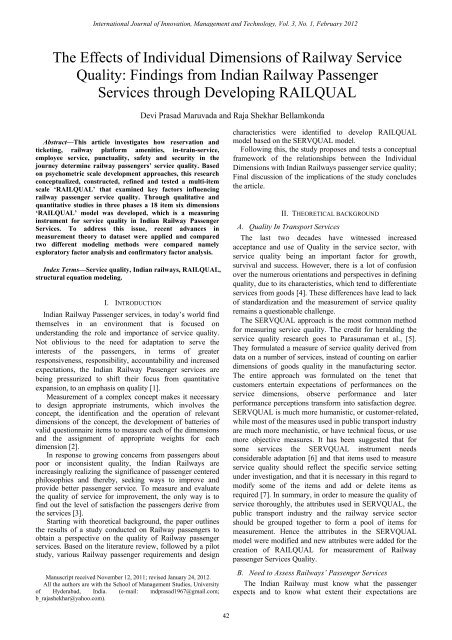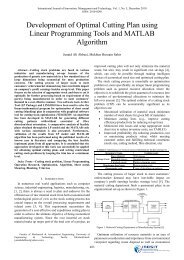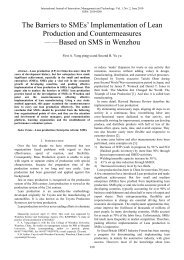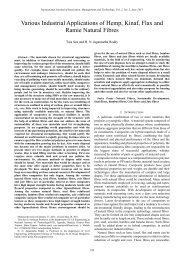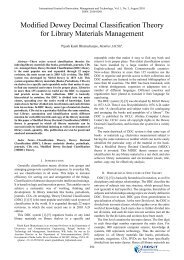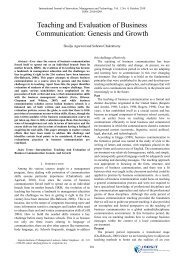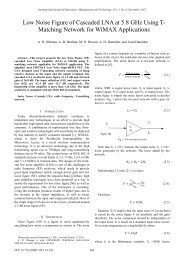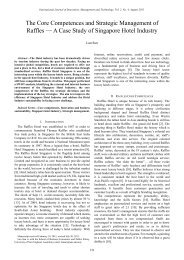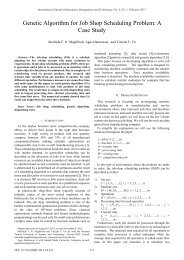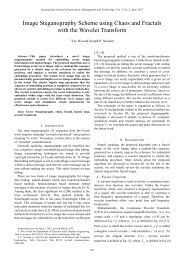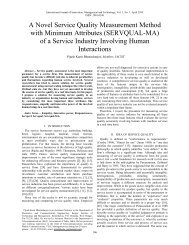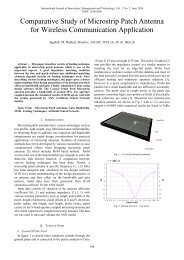The Effects of Individual Dimensions of Railway Service Quality - ijimt
The Effects of Individual Dimensions of Railway Service Quality - ijimt
The Effects of Individual Dimensions of Railway Service Quality - ijimt
You also want an ePaper? Increase the reach of your titles
YUMPU automatically turns print PDFs into web optimized ePapers that Google loves.
International Journal <strong>of</strong> Innovation, Management and Technology, Vol. 3, No. 1, February 2012<br />
<strong>The</strong> <strong>Effects</strong> <strong>of</strong> <strong>Individual</strong> <strong>Dimensions</strong> <strong>of</strong> <strong>Railway</strong> <strong>Service</strong><br />
<strong>Quality</strong>: Findings from Indian <strong>Railway</strong> Passenger<br />
<strong>Service</strong>s through Developing RAILQUAL<br />
Devi Prasad Maruvada and Raja Shekhar Bellamkonda<br />
Abstract—This article investigates how reservation and<br />
ticketing, railway platform amenities, in-train-service,<br />
employee service, punctuality, safety and security in the<br />
journey determine railway passengers’ service quality. Based<br />
on psychometric scale development approaches, this research<br />
conceptualized, constructed, refined and tested a multi-item<br />
scale ‘RAILQUAL’ that examined key factors influencing<br />
railway passenger service quality. Through qualitative and<br />
quantitative studies in three phases a 18 item six dimensions<br />
‘RAILQUAL’ model was developed, which is a measuring<br />
instrument for service quality in Indian <strong>Railway</strong> Passenger<br />
<strong>Service</strong>s. To address this issue, recent advances in<br />
measurement theory to dataset were applied and compared<br />
two different modeling methods were compared namely<br />
exploratory factor analysis and confirmatory factor analysis.<br />
Index Terms—<strong>Service</strong> quality, Indian railways, RAILQUAL,<br />
structural equation modeling.<br />
I. INTRODUCTION<br />
Indian <strong>Railway</strong> Passenger services, in today’s world find<br />
themselves in an environment that is focused on<br />
understanding the role and importance <strong>of</strong> service quality.<br />
Not oblivious to the need for adaptation to serve the<br />
interests <strong>of</strong> the passengers, in terms <strong>of</strong> greater<br />
responsiveness, responsibility, accountability and increased<br />
expectations, the Indian <strong>Railway</strong> Passenger services are<br />
being pressurized to shift their focus from quantitative<br />
expansion, to an emphasis on quality [1].<br />
Measurement <strong>of</strong> a complex concept makes it necessary<br />
to design appropriate instruments, which involves the<br />
concept, the identification and the operation <strong>of</strong> relevant<br />
dimensions <strong>of</strong> the concept, the development <strong>of</strong> batteries <strong>of</strong><br />
valid questionnaire items to measure each <strong>of</strong> the dimensions<br />
and the assignment <strong>of</strong> appropriate weights for each<br />
dimension [2].<br />
In response to growing concerns from passengers about<br />
poor or inconsistent quality, the Indian <strong>Railway</strong>s are<br />
increasingly realizing the significance <strong>of</strong> passenger centered<br />
philosophies and thereby, seeking ways to improve and<br />
provide better passenger service. To measure and evaluate<br />
the quality <strong>of</strong> service for improvement, the only way is to<br />
find out the level <strong>of</strong> satisfaction the passengers derive from<br />
the services [3].<br />
Starting with theoretical background, the paper outlines<br />
the results <strong>of</strong> a study conducted on <strong>Railway</strong> passengers to<br />
obtain a perspective on the quality <strong>of</strong> <strong>Railway</strong> passenger<br />
services. Based on the literature review, followed by a pilot<br />
study, various <strong>Railway</strong> passenger requirements and design<br />
Manuscript received November 12, 2011; revised January 24, 2012.<br />
All the authors are with the School <strong>of</strong> Management Studies, University<br />
<strong>of</strong> Hyderabad, India. (e-mail: mdprasad1967@gmail.com;<br />
b_rajashekhar@yahoo.com).<br />
characteristics were identified to develop RAILQUAL<br />
model based on the SERVQUAL model.<br />
Following this, the study proposes and tests a conceptual<br />
framework <strong>of</strong> the relationships between the <strong>Individual</strong><br />
<strong>Dimensions</strong> with Indian <strong>Railway</strong>s passenger service quality;<br />
Final discussion <strong>of</strong> the implications <strong>of</strong> the study concludes<br />
the article.<br />
II. THEORETICAL BACKGROUND<br />
A. <strong>Quality</strong> In Transport <strong>Service</strong>s<br />
<strong>The</strong> last two decades have witnessed increased<br />
acceptance and use <strong>of</strong> <strong>Quality</strong> in the service sector, with<br />
service quality being an important factor for growth,<br />
survival and success. However, there is a lot <strong>of</strong> confusion<br />
over the numerous orientations and perspectives in defining<br />
quality, due to its characteristics, which tend to differentiate<br />
services from goods [4]. <strong>The</strong>se differences have lead to lack<br />
<strong>of</strong> standardization and the measurement <strong>of</strong> service quality<br />
remains a questionable challenge.<br />
<strong>The</strong> SERVQUAL approach is the most common method<br />
for measuring service quality. <strong>The</strong> credit for heralding the<br />
service quality research goes to Parasuraman et al., [5].<br />
<strong>The</strong>y formulated a measure <strong>of</strong> service quality derived from<br />
data on a number <strong>of</strong> services, instead <strong>of</strong> counting on earlier<br />
dimensions <strong>of</strong> goods quality in the manufacturing sector.<br />
<strong>The</strong> entire approach was formulated on the tenet that<br />
customers entertain expectations <strong>of</strong> performances on the<br />
service dimensions, observe performance and later<br />
performance perceptions transform into satisfaction degree.<br />
SERVQUAL is much more humanistic, or customer-related,<br />
while most <strong>of</strong> the measures used in public transport industry<br />
are much more mechanistic, or have technical focus, or use<br />
more objective measures. It has been suggested that for<br />
some services the SERVQUAL instrument needs<br />
considerable adaptation [6] and that items used to measure<br />
service quality should reflect the specific service setting<br />
under investigation, and that it is necessary in this regard to<br />
modify some <strong>of</strong> the items and add or delete items as<br />
required [7]. In summary, in order to measure the quality <strong>of</strong><br />
service thoroughly, the attributes used in SERVQUAL, the<br />
public transport industry and the railway service sector<br />
should be grouped together to form a pool <strong>of</strong> items for<br />
measurement. Hence the attributes in the SERVQUAL<br />
model were modified and new attributes were added for the<br />
creation <strong>of</strong> RAILQUAL for measurement <strong>of</strong> <strong>Railway</strong><br />
passenger <strong>Service</strong>s <strong>Quality</strong>.<br />
B. Need to Assess <strong>Railway</strong>s’ Passenger <strong>Service</strong>s<br />
<strong>The</strong> Indian <strong>Railway</strong> must know what the passenger<br />
expects and to know what extent their expectations are<br />
42
International Journal <strong>of</strong> Innovation, Management and Technology, Vol. 3, No. 1, February 2012<br />
fulfilled. Understanding passenger needs and behavior is not<br />
an option but it is an absolute necessity for competitive<br />
survival [7]. <strong>The</strong> main problem with regard to assessing the<br />
quality <strong>of</strong> transport service quality is that it is composed <strong>of</strong><br />
several utilities. It is not possible to evaluate and measure<br />
the quality as single unit since it is a bundle <strong>of</strong> benefits [8].<br />
Main factors to be compared especially when competing<br />
modes are involved are travel cost, convenience, comfort,<br />
dependability travel time and safety. Since satisfaction is a<br />
function <strong>of</strong> expected performance and actual performance,<br />
market research would reveal what the users <strong>of</strong> railway<br />
passengers expect and satisfaction derived there from. By<br />
researching passenger needs and behaviors, and by asking<br />
passengers’ it will be known about the system and the ways<br />
and means to serve better their needs [4].<br />
III. EMPIRICAL STUDY<br />
A. Objective<br />
This study conducted with the objective <strong>of</strong> identifying an<br />
integrated framework that would lead to <strong>Quality</strong> in <strong>Railway</strong><br />
passenger services, through usage <strong>of</strong> quantitative and<br />
qualitative techniques. This involved the determination <strong>of</strong><br />
railway service quality and development <strong>of</strong> RAILQUAL.<br />
B. Questionnaire Design and Measurement<br />
To develop RAILQUAL in-depth interviews and focus<br />
group discussions were held with railway staff, railway<br />
passengers and academics in the transportation field. During<br />
the in-depth interviews participants were asked to express<br />
their views on rail passenger service quality – especially<br />
what comprises rail passenger service quality, what kind <strong>of</strong><br />
service railways provide, and how railway passenger<br />
service quality differs from service quality in other service<br />
industries.<br />
C. Passenger Survey<br />
<strong>The</strong> survey was conducted at the Secunderabad station <strong>of</strong><br />
South Central <strong>Railway</strong> in September2010.Sampling was<br />
done by interviewing randomly selected passengers, at<br />
different times <strong>of</strong> day, on every day <strong>of</strong> the week, over a 3-<br />
week period. A total <strong>of</strong> 234 questionnaires were found<br />
complete and valid for analysis.<br />
D. Variable Conceptualization and Instrument<br />
Based on literature review, and with particular emphasis<br />
on the various models and performance indicators in rail<br />
transport,variables and items for the study were<br />
conceptualized.<strong>The</strong>se items were adapted and incorporated<br />
in the questionnaires that were distibuted to the passengers<br />
to examine the validity and reliability <strong>of</strong> the scale during the<br />
pilot study stage to enable a quantitative and statistically<br />
proven identificaiton <strong>of</strong> passenger requirements. After focus<br />
group discussions 45 attributes were identified in which 9<br />
were deleted after taking expert opionions. <strong>The</strong> following<br />
36 modified attributes to suit <strong>Railway</strong>s have been identified<br />
for developing RAILQUAL scale with literature review,<br />
focus group discssions and taking expert opinions.<br />
E. Railqual <strong>The</strong>ory Building throug Exploratory Factor<br />
Analysis<br />
Data analysis proceeds in two steps. First the exploratory<br />
factor analysis was used to identify the underlying<br />
dimensions <strong>of</strong> services quality <strong>of</strong> railway passenger services.<br />
For this the sample was split into two approximately equal<br />
sub samples: sample1 (n=117) and sample 2 (n=117) this<br />
was done by randomly selecting ~50 percent <strong>of</strong> the cases<br />
using the filtering algorithm in SPSS.<br />
TABLE I: IDENTIFIED ATTRIBUTES<br />
1.convenience <strong>of</strong> reservation and ticketing<br />
2.promptness and accuracy in reservation and ticketing<br />
3.provision <strong>of</strong> information about train times/platforms<br />
4.the upkeep/repair <strong>of</strong> station buildings and platforms<br />
5.ticket purchasing facilities<br />
6.amenities at the station<br />
7enquiry handling at ticket counter<br />
8.train departure on time<br />
9.the length <strong>of</strong> time the journey was scheduled to take<br />
10.train arrival on time without late ( ie itinerary accuracy)<br />
11.convenient train schedule<br />
12.connections with other train services<br />
13.catering and other facilities at station<br />
14.condition <strong>of</strong> fans and air conditioners<br />
15.train availability<br />
16.the space for luggage<br />
17.coach maintenance<br />
18.connections with other forms <strong>of</strong> public transport<br />
19.the ease <strong>of</strong> being able to get on and <strong>of</strong>f the train at station platform<br />
20.courtesy <strong>of</strong> employees<br />
21.how request to railway staff was handled<br />
22.the attitudes and helpfulness <strong>of</strong> the railway staff<br />
23.cleanliness <strong>of</strong> the train<br />
24.the toilet facilities<br />
25.the easiness <strong>of</strong> ticket purchasing<br />
26.availability <strong>of</strong> railway staff on train<br />
27.the comfort <strong>of</strong> seating area ( ie berths and seats)<br />
28.the provision <strong>of</strong> information during journey<br />
29.journey comfort<br />
30.quality and price <strong>of</strong> catering in train<br />
31personal security at the station<br />
32.facilities for parking<br />
33.personal security on train<br />
34.safety <strong>of</strong> train journey<br />
35.the value <strong>of</strong> money for price <strong>of</strong> your ticket<br />
36.security <strong>of</strong> luggage on train<br />
Next an exploratory factor analysis was performed on 36<br />
attributes <strong>of</strong> the measurement scale using principal<br />
component analysis with varimax rotation. An orthogonal<br />
rotation was chosen for the sake <strong>of</strong> simplicity. Next,<br />
confirmatory factor analysis was used to confirm the factor<br />
structure <strong>of</strong> the service quality dimensions. Qualitative<br />
validity was tested through the theoretical study as well as<br />
through expert comments. <strong>The</strong> test for quantitative validity<br />
was done through an Exploratory Factor analysis. <strong>The</strong><br />
principal component method was used. With Eigen values<br />
above 1 and the maximum iterations for convergence as 100,<br />
the Varimax Rotation was applied and Rotated factor<br />
43
International Journal <strong>of</strong> Innovation, Management and Technology, Vol. 3, No. 1, February 2012<br />
loadings examined. Factor loadings above α value <strong>of</strong> 0.60<br />
were considered. Internal consistency was examined<br />
through a reliability analysis. <strong>The</strong> Cronbach’s α model,<br />
inter-item-correlation and covariance were used and alpha<br />
values over 0.70 were considered [9].<br />
As far as passenger requirement were concerned, the<br />
validity and reliability identified a total <strong>of</strong> 36 items which<br />
grouped under six factors/constructs. <strong>The</strong> Cronbach’s α<br />
values for the different factors <strong>of</strong> passenger requirements<br />
ranged from 0.711 to 0.854 indicating that the scale was<br />
internally consistent and reliable[9].<br />
RAILQUAL<br />
ATTRIBUTES<br />
TABLE II: THE RESULT OF FACTOR ANALYSIS<br />
RAIL QUAL DIMENSIONS<br />
1 2 3 4 5 6<br />
X23 .814<br />
X24 .697<br />
X29 .602<br />
X30 .680<br />
X3 .735<br />
X4 .668<br />
X6 .648<br />
X18 .702<br />
X33 .807<br />
X34 .753<br />
X36 .712<br />
X8 .697<br />
X9 .747<br />
X10 .635<br />
X12 .702<br />
X1 .681<br />
X2 .751<br />
X21 .775<br />
X22 .630<br />
Cronbach alpha .854 .826 .807 .832 .804 .711<br />
This resulted in the development <strong>of</strong> service quality<br />
dimensions and measurement items suitable for the railway<br />
passenger sector. <strong>The</strong> Instrument for measuring railway<br />
passenger quality encompasses six dimensions namely<br />
reservation and ticketing, railway platform amenities, intrain-service,<br />
employee service, punctuality, safety and<br />
security in the journey.<br />
F. Railqual <strong>The</strong>roy Tesing through Confirmatory Factor<br />
Analysis<br />
After identifying six clear factors through exploratory<br />
factor analysis, the next stage is to confirm the factor<br />
structure on sample 2. Structural equation modeling (SEM)<br />
using AMOS 16.0 was used to perform the confirmatory<br />
factor analysis. Confirmatory factor analysis revealed that<br />
the measurement attributes loaded in accordance with the<br />
patter value in the factor analysis.<br />
Model Fit<br />
<strong>The</strong> measurement model indicated an acceptable fit <strong>of</strong> the<br />
data (Chsquare =1195.179, df = 120, p
International Journal <strong>of</strong> Innovation, Management and Technology, Vol. 3, No. 1, February 2012<br />
the inter-construct correlations, which supports the<br />
discriminant validity <strong>of</strong> the constructs. Thus, the<br />
measurement model reflects good construct validity and<br />
desirable psychometric properties.<br />
IV. CONCLUSION<br />
<strong>The</strong> study has presented a model <strong>of</strong> individual dimension<br />
<strong>of</strong> <strong>Railway</strong> passenger service quality. This study disclosed<br />
that there is significant relationship between in-train service,<br />
Employee service, Train punctuality, platform amenities,<br />
Reservation and Ticketing and safety and security are<br />
having significant positive influence on overall <strong>Railway</strong><br />
passenger service quality. <strong>The</strong> <strong>Railway</strong> administration feels<br />
that the passenger is pleased with if a few new trains are<br />
announced at regular intervals and fares are kept low. But<br />
there must be at least being basic facilities at stations and<br />
trains. <strong>The</strong> chaos at the railway station is due to the lack <strong>of</strong><br />
attention paid to their running.<br />
<strong>The</strong> platforms at major stations are arguably among the<br />
dirtiest in the world. <strong>The</strong>y lack proper signage, seating<br />
facilities and communication mechanisms. Lifts and<br />
escalators are nonexistent in most stations though the<br />
<strong>Railway</strong>s are the most preferred option for long distance<br />
travel in India. More personnel need to be deployed not just<br />
to manage crowds but also to help passengers with precise<br />
information. Proper communication between <strong>of</strong>ficials and<br />
passengers itself could streamline passenger flow and<br />
facilitate better patronage. But these are possible only if<br />
policies and priorities are set with the passenger in focus. A<br />
public utility like the <strong>Railway</strong>s has to be judged not merely<br />
on the bottom line, but on the quality <strong>of</strong> service it provides.<br />
<strong>The</strong> unfortunate part is even when the <strong>Railway</strong>s have<br />
claimed operational pr<strong>of</strong>its; its record on passenger<br />
amenities was nothing to crow about. <strong>The</strong> <strong>Railway</strong>s has to<br />
revolve around the passenger. <strong>The</strong> passenger must be seen<br />
as consumer with privileges and not as a captive user with<br />
limited choices.<br />
REFERENCES<br />
[1] G. Raghuram and Rachna Gangawar., Indian <strong>Railway</strong>s in the past<br />
Twenty Years: Issues, performance and Challenges, W.P.No. 2008-<br />
07-05.<br />
[2] C. Gronroos, “A service quality model and its marketing<br />
implications,” European Journal <strong>of</strong> Marketing, no 4, pp. 36-44, 1984.<br />
[3] A. Parasuraman, “A conceptual model <strong>of</strong> service quality and its<br />
implications for future research,” Journal <strong>of</strong> Marketing, vol.49, fall,<br />
pp. 41-50, 1985.<br />
[4] Devi Prasad M and Raja Shekhar B, “Measuring service quality <strong>of</strong><br />
Indian railway passenger services using RAILQUAL model,” IEEE<br />
ICMIT10, pp 292-296, 2010<br />
[5] A. Parasuraman, V.A. Zeithaml, and L.L. Berry, “Reassessment <strong>of</strong><br />
expectations as a comparison standard in measuring service quality:<br />
Implications for further research,” 1994.<br />
[6] A. Parasuraman, V.A. Zeithaml, and L.L.Berry, “RAILQUAL: a<br />
multiple-item scale for measuring consumer perceptions <strong>of</strong> service<br />
quality,” Journal <strong>of</strong> Retailing, vol. 64, Springer, pp.12-40, 1988.<br />
[7] P.A. Dabholkar, D.I Thore, and J.O. Rentx, “A measure <strong>of</strong> service<br />
quality for retail stores:scale development and validation,” Journal <strong>of</strong><br />
Academy <strong>of</strong> Marketing Science, vol. 24, winter, pp. 3-16, 1996.<br />
[8] Churchill and AJr. Gilbert, “A paradigm for developing better<br />
measures <strong>of</strong> quality constructs,” Journal <strong>of</strong> Marketing Research,<br />
vol.16, February, 1979.<br />
[9] L.J Cronbach, “Coefficient alpha and internal structure test,”<br />
Psychometica, 16, pp.297-300, 1951.<br />
[10] Brown, M&Cudeck, R. “Alternative ways <strong>of</strong> assessing model fit,” in<br />
LISERAL8.5.1 version Tutorials.<br />
[11] R.H Hoyle, “Structured equation modeling: Issues, and applications,”<br />
Thousand Oaks, CA; Sage, 1995.<br />
[12] J. F Hair, R. E.Anderson, R. L. Tatham, and W. C. Black,<br />
Multivariate Data Analysis, Macmillan, New York, 1998.<br />
Devi Prasad Maruvada is a Research Scholar in<br />
School <strong>of</strong> Management Studies, University <strong>of</strong><br />
Hyderabad, India. He is a Post Graduate in Management<br />
and also Post Graduate in Computer Applications. He<br />
has published around 9 papers in International<br />
Management Journals.<br />
Raja Shekhar Bellamkonda is a Pr<strong>of</strong>essor at School <strong>of</strong><br />
Management Studies, University <strong>of</strong> Hyderabad. He did<br />
his PhD from Kakatiya Univesity,India. He has<br />
published around 35 papers in national and international<br />
journals and conferences. He has authored 3 books.<br />
45


